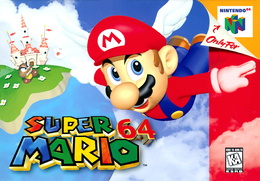The 'Shroom:Issue LXXVIII/A History of Video Games
| A History of Video Games | |||||||||
|---|---|---|---|---|---|---|---|---|---|

| |||||||||
| Developer | Nintendo EAD | ||||||||
| Publisher | Nintendo | ||||||||
| Platform(s) | Nintendo 64/Virtual Console | ||||||||
| Release date | Nintendo 64: Virtual Console: | ||||||||
| Genre | Platformer | ||||||||
| Rating(s) |
| ||||||||
| Mode(s) | Single player | ||||||||
| Media | 64 Mbit (8 MiB) cartridge 90 blocks of memory (Virtual Console) | ||||||||
| Input | Nintendo 64: Wii:
| ||||||||
Welcome
Welcome to the first ever History of Video Games as written by me, Chuck Ballymoo. I hope to carry on a tradition of quality video game history articles such as Toad85 submitted before retiring nearly one year ago. On this month in 1996, Nintendo launched the Nintendo 64 in North America and changed the world forever. Mario emerged.
Nintendo was in deep trouble in her home country of Japan back in the long ago days of 1996. The 16-bit era was folding, and Nintendo faced some serious competition in the next-gen hardware arena from neighboring Sony. The PS1 was in a dead-heat with the Sega Saturn in Japan, and in America was making inroads. The PlayStation and Saturn used CD-ROMs, but Nintendo was the last holdout with using cartridges for the 64, which was named after the console's 64-bit graphics-processor. This riled many a game developer, and resulted in some of them to migrate their popular Famicon and Super Famicon video game series over to the Saturn and PS1. That left Nintendo in quite a pickle, and had only Miyamoto's brilliance to stand on.
The 3D Revolution
Enter Super Mario 64. The game took clever advantage of the console's advanced graphical processing power and was among the first adventure games in 3D. Even now, many consider it one of the greatest games ever made. It is the epitome of evolution of gaming at it's finest. Super Mario Bros. 3 and Super Mario World added a few elements of non-linearity to Mario's world, but the freedom of movement afforded to the system by it's 64 -bit power made it like no adventure game the world had ever seen before. From what I gather, one can read about the awestruck feeling of delving into the castle grounds for the first time having never been exposed to such a thing, but to really grasp what was felt in it's entirety, one simply must have been there.
Simply jumping from platform to platform and bouncing/dodging enemies to reach a Goalpost was a sequestered goal. The emphasis became placed on exploration, and linearity went out the window. Mario is required to explore the worlds inside the paintings around him and find all 120 Power Stars. After attaining seventy, Mario faces Bowser for the third and final time. After his victory, he is teleported back outside the Princess's castle, where his adventure began. Peach escapes from her magical stain glassed imprisonment, floats downward from the sky and kisses Mario on the nose. She then takes him inside for a slice of that cake (a reference to a slice of cake would go on to be a recurring gag in the series, such as the Galaxy series). Lakitu, manning the camera, captures the cutscene from many different angles. As one of the first 3D games where any such camera work was possible, this showed how far in such an incredibly short time cinema in games had come and showed a glimpse of what was to come.
Conclusion
The world was mesmerized. While not the first 3D adventure game, Super Mario 64 was the first to do it right, and the first to usher in greatness. A gamer in late September of 1996 did not know what to expect when he turned on his new console. No one knew how great the potential was for the 3D platformer and all 3D games in general. But all that changed 17 years ago this month.
| Issue LXXVIII | |
|---|---|
| Previous Section | |
